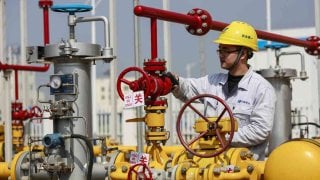China Is No Longer Driving Global Oil Demand
The latest data shows a plunge in Chinese oil consumption owing to the increased availability of electric vehicles and natural gas.
For many years, the outlook for the world oil market has rested heavily on China, as it has been by far the most significant driver of demand growth in this century. But now, twenty years after the landmark 2004 surprise, when Chinese demand reached over 3 million barrels per day year-on-year, stoked fears of scarcity and drove up prices, there is a growing consensus that China’s oil demand will soon peak. That does not necessarily mean that global demand will peak shortly thereafter, as it reflects the specifics of the policy context in China. Still, it makes it a lot harder to envision a period of lasting market tightening in the future, which many oil bulls and OPEC+ producers had predicted would take place in the mid-to-late 2020s.
The two largest state-owned oil companies in China, CNPC and Sinopec, both issued studies in December that showed that the demand for transportation-sector goods has already peaked, with total demand set to peak soon. Both expect full-year data for 2024, when released, to show declines in gasoline and highway diesel usage, which has been accelerated by the faster-than-previously-expected gains in sales of electric vehicles (EVs) and the increasing use of natural gas as an alternative fuel for heavy trucks. The only oil-based transportation fuels that are still growing are jet fuel and kerosene. Sinopec forecasts diesel use to fall by 5.5 percent in 2025 from 2024 levels and gasoline use to fall by 2.4 percent. Fully 22 percent of new heavy trucks sold in the first three quarters of 2024 used natural gas as a fuel, and EVs are expected to displace 15 percent of gasoline consumption in 2025 relative to where it would have been otherwise.
The decline in oil use as a transportation fuel is being more than offset in the short-term by gains in demand for industrial consumption, which Sinopec shows increasing by 55 percent from 2023 to 2035. Still, total demand in their forecast tops out in 2027 and begins a gradual decline as the fall in transportation demand accelerates. CNPC has a slightly more bullish forecast but still shows the peak for total demand being reached in 2060.
Global oil demand forecasts from major agencies like the IEA and OPEC have diverged sharply in recent years, driven in large part by differing assumptions about how much government policies will shift in response to the desire to mitigate climate change. Both have been accused of being influenced by politics and wishful thinking, with the IEA’s baseline scenario envisioning rapid adoption of mitigation measures and OPEC foreseeing a world in which demand growth is adequate to keep most participants in OPEC+ financially comfortable.
The IEA baseline has global demand peaking by 2030, with the much less realistic “Announced Policies Scenario,” in which all countries meet their stated climate change mitigation goals, showing a peak in 2025. OPEC shows slow growth after 2035 but has no peak. In my opinion, the OPEC forecast is the less credible of the two. The IEA’s baseline is probably still too optimistic (from their perspective) about the impact of mitigation measures on demand. Still, the impact of Chinese policies on demand is now not open to disagreement.
We are still likely to see a wide range of demand outcomes, which will see demand continuing to grow elsewhere after China peaks. In the United States, the incoming Trump administration is set to undo much of what Biden put in place. This may include ending the $7,500 tax credit that subsidizes EV purchases and rolling back Biden’s automobile emissions standards, which would have effectively forced EVs to contribute to half of U.S. passenger vehicle sales by the mid-2030s.
As India takes China’s place as the largest source of demand growth, government policy remains aimed in a protectionist “make in India” direction with no major incentives to decarbonize transportation. New Delhi is, however, trying to lure Tesla into investing in the country, aiming for its high-end market segment with lower tariffs for expensive cars. One big question at the moment is how the rest of the world will treat lower-end Chinese EVs, given that they have been able to produce some models with prices as low as $12,000. If others do not raise protectionist barriers to Chinese EVs, they could start replacing the inexpensive Japanese and Korean gasoline cars and light trucks that have dominated most developing automotive markets—a move that could bring global peak demand closer.
It is still true that aviation and petrochemical demand for oil in the developing world has a lot of room for growth, which will probably take peak global demand out past 2030, if only for a few years. However, it is much more difficult to envision a future period of renewed concerns about the scarcity of oil without continued demand growth from China. Countries like Russia and Saudi Arabia, which had planned to be able to replenish their coffers with one last period of scarcity and high prices, are likely to be disappointed.
Greg Priddy is a Senior Fellow at the Center for the National Interest and does consulting work related to political risk for the energy sector and financial clients. Previously, he was director of global oil at Eurasia Group and worked at the U.S. Department of Energy.
Image: Humphery / Shutterstock.com.

